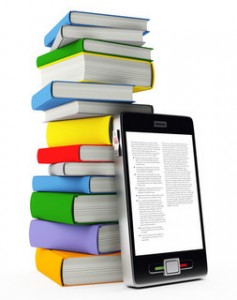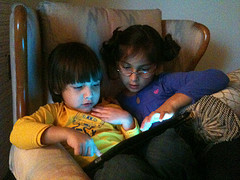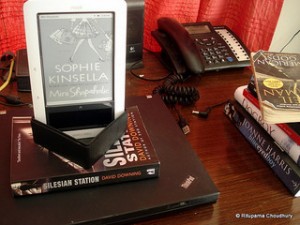
-Percy Parry
‘The most technologically efficient machine that man has ever invented is the book’. –Northrop Frye
Considering that this statement was made with printed books in mind, will it still remain uncontested with the dawn of eBooks in the recent years? Comparing a book with an eBook is like comparing an analogue watch with a digital one, the latter being more sophisticated than the former. No one can doubt the convenience of the flexibility of the format that a reader gets in an eBook. But nevertheless they will never be able to successfully replace the experience of a printed book. But who says they need to? eBooks are a whole different figure and form by themselves as long as they do not attempt to imitate their printed cousins.
We are still at the very early stages of eBook development. Like the early films and their visual effects, the boundaries in eBook development that will ultimately define its format have yet to be pushed.
‘The issue with eBooks as they exist now is the lack of innovation in the department of user experience. Like the first television shows that only played grainy recordings of theater shows, the eBook is a new medium that has yet to see any true innovation, and resorts to imitating an old medium. This is obvious in skeuomorphic (made to imitate) visual cues of eBook apps. Designers have tried incredibly hard to mimic the page-turns and sound effects of a real book, but these ersatz interactions satisfy a bibliophile as much as a picture of water satisfies a man in the desert,’ writes businessman Kane Hsieh in a piece for Gizmodo.
He continues, “There is no reason I need to turn fake pages. If I’m using a computer to read, I should be able to leverage the connectivity and processing power of that computer to augment my reading experience: eBooks should allow me to read on an infinite sheet, or I should be able to double blink to scroll. I should be able to practice language immersion by replacing words and phrases in my favorite books with other languages, or highlight sections to send to Quora or Mechanical Turk for analysis. There are endless possibilities for eBooks to make reading more accessible and immersive than ever, but as long as eBooks try to be paper books, they will remain stuck in an uncanny valley of disappointment.’
There are always going to be eBooks that mimic a regular printed copy, like eBooks based on older works, or those that would like to do so because of market reasons.

eBooks have more advantages than conventional books. We don’t read eBooks like we read a printed version. Printed editions have a monopoly on our attention. There exists only a one-way interaction between the reader and the book, that is from the book to the reader and not vice versa. So basically printed editions are static. On the other hand, there exists a two-way interaction between the user and an eBook. eBook software allow readers to translate texts into languages of their choice, a feature which was not covered by printed editions. Some e-Readers allow the user to read in low-light or even total darkness. Many e-Readers have inbuilt software that help with easier interactions between the user and the device. The newer software can display motion, change the size or font of the text, and use text-to-speech software to read the text aloud for the visually impaired or dyslectic people and sometimes just for the user’s convenience. Software are also available that help search for key terms, definitions, allow highlighting, bookmarking and annotation. eBooks also gather a great deal of information about the user’s reading habits, like when he begins to read, when he stops, his pace while reading, when and what pages he skips, when and what he re-reads, what he chooses to highlight, what he chooses to read, etc. For a critic like Franco Moretti, the author of Graphs, Maps, Trees: Abstract Models for Literary History, this data is priceless.
An eBook can be bought, downloaded and used immediately, as compared to the ordeal one goes through when one buys or borrows a book – the ordeal of going to a bookshop, or a public library during limited hours, or waiting for a delivery when purchased online or by other means. Besides, the production of e-books does not consume paper and ink. Printed books use 3 times more raw materials and 78 times more water to produce. Also, depending on the type of digital rights management (DRM) implementation, e-books can be backed up so as to recover them with ease in the case of loss or damage. And there may be possibilities of recovering a new copy without any cost from the distributor. As compared to the traditional publishing methods, it is cheaper and easier for authors to self-publish eBooks. Sometimes the dispersal of a free eBook copy can also stimulate the sales of the printed version.
eBooks allow an author to change sections, change plot points as per the user input, even change the entire setting based on a user’s location. That means eBooks are capable of things that regular books are not. For lack of a better word, eBooks are a whole different entity. In an article in The Guardian, Stuart Kelly proposes that eBooks should be treated differently from regular print books because the fantastic possibilities of eBooks should not be bound to the confines of print and pages. Kelly calls for what the proponents of eBooks have been saying for a while: ‘Let’s treat it like a bold new invention, rather than a standard digital copy of a physical book.’
However, the adoption of eBooks in India has had its peculiarities when compared to markets in the West:
– eBooks in India have primarily found acceptance in the professional and academic genres. This, as opposed to the traditional Anglo markets where purchases of eBooks are primarily in the popular categories
– eBook retail sites are few and buyers have mostly purchased eBooks directly from the publishers
– the high cost of eReaders and similar devices has had an impact on eBook purchase. A mid category iPad will cost around INR 30,000 and a Kindle Fire would cost anything between INR 10,000-15,000.
– Piracy remains a constant threat and readers often prefer downloading a book to purchasing one.
– A large number of people are still clueless on how to “use” an eBook. It will take people some time getting used to the idea of consuming digital content
– Publishers haven’t jumped on the eBook development bandwagon yet. Those, like Penguin and Zubaan that are developing eBooks are doing so very cautiously.
– A lot of material that is primarily in Indian languages cannot be rendered on eBooks. Devices meant for the sole purpose of making books in these languages accessible in the electronic format have failed.

Australia and India have joined the UK and the US as world leaders in eBook adoption rates, according to Bowker Market Research’s Global eBook Monitor (GeM). Buyers in the UK and Australia target adult fiction as opposed to the professional books and academic textbooks that buyers concentrate on in India and South Korea. The report also reveals that the eBook market is set for a rapid increase in Brazil and India. Over 50% people from these two countries said that they were likely to buy an eBook in the next 6 months, which would double the number of eBook buyers in India, and triple the number of eBook buyers in Brazil.
With the rise in adoption of large screen tablets and smart phones in India, Google has launched its eBook store(Play Books), through Play Store, in India. Though the smartphone market share in India is just around 15%, Google’s Android phone make up 56.4% of this number. This development can therefore catalyze the consumtion of eBoks because adoption of smartphones is growing by leaps and bound in the country.
At the World Book Fair Delhi 2013, Rockstand, an eBook and e-Magazine application for mobiles and tablets unveiled their first regional eBook collection for its readers at the Book Fair. ‘This content alone will entice readers in various cities as well as readers who are on the look out for regional content like Hindi, Gujarati, Marathi. They will now have access to all these books on our platform. In total we are introducing regional content in 18 languages soon,’ says Praveen Rajpal, Founder, Director, RockASAP Retail Pvt. Ltd.
Publishers such as RockASAP have developed applications that are available free of cost and allow the book to be read on the user’s smart phone. Like other such devices, the application allows the user to change the font size or take notes. Similarly it has partnered with many publishers to make their books available for sale. There is hope that many other publishers offer such services.
eBooks will become a different entity in themselves in the same way that board games became video games. In the beginning, they were merely the limited versions of the original, physical, editions. They later came to be more user-oriented. While some eBooks will choose to remain similar to the concepts of a regular printed edition, enhanced eBooks will take a form of its own, complete with every technological wizardry and component.
Percy Parry interns with CinnamonTeal Publishing.